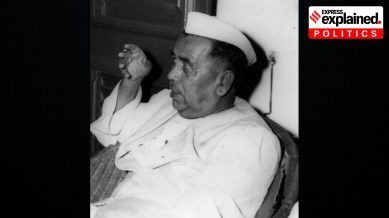Shyamlal Yadav is one of the pioneers of the effective use of RTI for investigative reporting. He is a member of the Investigative Team. His reporting on polluted rivers, foreign travel of public servants, MPs appointing relatives as assistants, fake journals, LIC’s lapsed policies, Honorary doctorates conferred to politicians and officials, Bank officials putting their own money into Jan Dhan accounts and more has made a huge impact. He is member of the International Consortium of Investigative Journalists (ICIJ). He has been part of global investigations like Paradise Papers, Fincen Files, Pandora Papers, Uber Files and Hidden Treasures. After his investigation in March 2023 the Metropolitan Museum of Art, New York returned 16 antiquities to India. Besides investigative work, he keeps writing on social and political issues. ... Read More
Chief Ministers of Bihar | K B Sahay: the CM under whom Congress lost its first majority
In the lead up to the Assembly elections in Bihar, this is the fourth part of a new series on the chief ministers of Bihar, from Shri Krishna Sinha to Nitish Kumar

Bihar boasts of one of the most fascinating political histories in India. As it heads to Assembly polls next month, The Indian Express brings a series of articles that tell the history of Bihar politics through the tenure of its 23 chief ministers. This article tells the story of K B, Bihar’s fourth CM. You can click here to read the previous edition on Binodanand Jha, the Bihar CM who got ‘Kamrajed’.
***
monthly limit of free stories.
with an Express account.
After Binodanand Jha was forced to step down due to the Kamaraj Plan, the Congress Legislature Party (CLP) met to elect a new chief minister on September 24, 1963. Veteran Congressman S K Patil came from Bombay to oversee the polls.
Krishna Ballabh Sahay emerged victorious over Birchandra Patel, the outgoing Finance Minister, backed by Jha. Sahay was sworn in as CM on October 2.
Sahay’s rise, however, was defined by the erosion of the autonomy of Congress state units and the growing influence of the High Command sitting in New Delhi. Sahay, for instance, travelled to New Delhi to consult with central leaders before forming his ministries. It took several meetings, including one at Lal Bahadur Shastri’s residence with Birchandra Patel, to finalise the cabinet.
Sahay’s ministry would be the last of an undivided Congress in Bihar: the party lost its majority in the 1967 Assembly polls, and then suffered from a split in 1969.
Born near Fatuha in Patna to a Kayastha family, Sahay was raised in Hazaribagh, where his father served as a police inspector. Like his predecessors, he too was a veteran of the freedom struggle, and a member of the Constituent Assembly.
Notably, while serving as the Revenue Minister in Shri Krishna Sinha’s cabinet, Sahay played a crucial role in drafting and implementing the Zamindari Abolition Act of 1949. While initially closely allied to Shri Babu, Bihar’s first CM, by the late 1950s, Sahay had grown closer to his rival Anuragh Narain Sinha.
Sahay had won the 1952 Assembly polls from the two-member Giridih-cum-Dumri constituency. However, his role in abolishing Zamindari led to strong opposition from landlords, leading to his defeat in 1957 at the hands of Raja Kamakhya Narain Singh.
But Sahay remained politically active, and made a comeback in the 1962 polls, before becoming the CM in 1963.
Sahay’s tenure came at a time when Congress, especially after Jawaharlal Nehru’s death, faced unprecedented challenges.
The 1962 India-China War and the 1965 India-Pakistan War had left a major impact on national politics. Meanwhile, the emergence of the Samyukta Socialist Party (SSP), led by Dr Ram Manohar Lohia, led a concerted anti-Congress wave in many states. Lohia’s party appealed to farming communities and backward castes — constituencies that would fundamentally alter Bihar politics in the years to come.
Within the Congress, internal conflicts strained Sahay’s leadership. The rejection of Birchandra Patel, a Kurmi (OBC), for CM in 1963 fueled discontent among OBCs. Despite appointing OBC leaders like Ram Lakhan Singh Yadav to his cabinet, Sahay could not fully address these grievances.
Moreover, when Yadav demanded 100 tickets for OBC candidates in the 1967 polls, there was significant pushback from the state’s upper caste leaders, further complicating matters for the Congress high command. At the time, all prime positions in the government and the party organisation remained with the upper castes.
***
In the backdrop of these internal and external pressures, the 1967 elections proved disastrous for the Congress.
On January 5, 1967, police firing on protesting students in Patna resulted in numerous deaths, and sparked a statewide unrest. The opposition capitalised on this, forming a united front against the Congress.
The polls, which took place in February, saw Congress winning only 128 out of 318 seats in the Assembly. Sahay himself suffered an embarrassing 20,000-vote defeat to Mahamaya Prasad Sinha in Patna West while also losing from Hazaribagh, his bastion. The SSP won 68 seats, the Bharatiya Jana Sangh 26, the Communist Party of India 24, and the Praja Socialist Party (PSP) 18. This marked the end of Congress’s dominance in Bihar.
On March 5, 1967, the Sanyukta Vidhayak Dal (SVD) government replaced Sahay’s administration as the first non-Congress government in the state.
In October 1967, the new government under Mahamaya Prasad Sinha formed a commission under retired Supreme Court Justice T L Venkatarama Aiyar to investigate corruption allegations against Sahay and some of his ministers.
In November 1969, when the Congress split, Sahay joined Congress (O) alongside leaders like Morarji Desai. In 1974, at the age of 75, he was elected to the Bihar Legislative Council before tragically dying in a road accident later that year.
Next: The first non-Congress government in Bihar